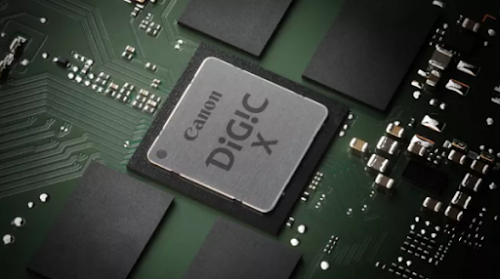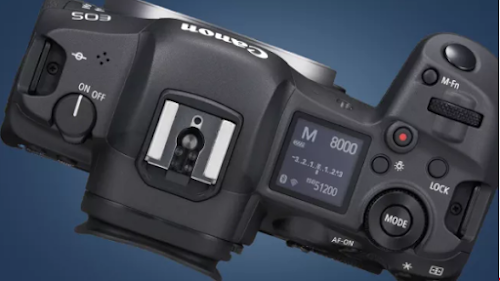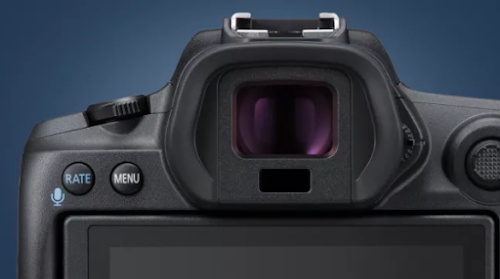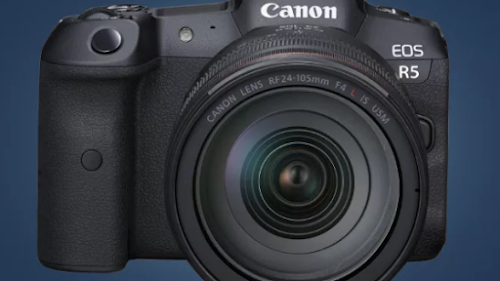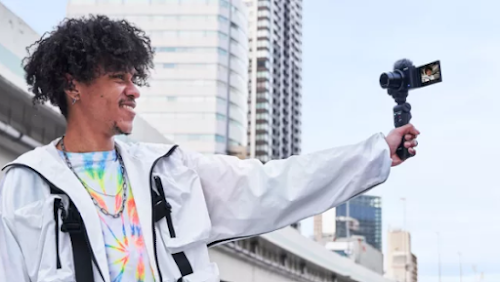Standard has tossed the kitchen sink at this one
(Image credit: Future)
The Canon EOS R5 has formally landed – and like a spaceship from a measurement where Canon really makes the best mirrorless cameras it can, it's the most impressive half breed camera for stills and video we've at any point seen. Also, by very some separation.
Obviously, crude force doesn't really mean the 45MP Canon EOS R5 will be the best mirrorless camera at any point made. In any case, the recently uncovered specs, which fill in all the spaces that were missing from Canon's prior mystery declarations, set a really amazing new full-outline benchmark for Nikon, Sony and Panasonic to coordinate.
We definitely knew a great deal about the Canon EOS R5 from its declarations prior this year. These secrets uncovered that it would be a half and half camera equipped for shooting 8K video utilizing the full width of its sensor, with in-self-perception adjustment (IBIS) and that the capacity to run through 12fps stills with its mechanical screen (or 20fps utilizing its electronic equal).
So what's happening from the official revealing? The short form is that the EOS R5 has another 45MP sensor, an IBIS framework that can present to eight stops of adjustment, and will cost $3,899/£4,199 (around AU$7,585) when it goes at a bargain on July 30.
Yet, there's significantly more than that for picture takers to get amped up for. For an inside and out gander at the EOS R5's recently declared highlights, read on for the eight new things we've found out about the full-outline lead today. Also, we've had a few hands-on time with the new camera
1. Its new 45MP sensor could catch more detail than any Canon camera ever
(Image credit: Future)
One of the key specs missing from prior Canon EOS R5 secret declarations was its goals. All things considered, that is currently been replied: it will have a fresh out of the plastic new 45MP sensor. This implies it ought to be perfect for any semblance of scene picture takers, who request most extreme detail and trimming potential.
That is not the finish of the story, either. Ordinance disclosed to us that despite the fact that the EOS R5's sensor is 'just' 45MP, it could level out-resolve past 50MP cameras like the Canon EOS 5DS.
As Canon Product Marketing Specialist David Parry let us know: "Despite the fact that it's 45MP, we're stating this [the Canon EOS R5] might be the most elevated settling camera we've at any point delivered.
"We have the 5DS and 5DSR, which are 50MP, but since the low-pass channel on here has been totally overhauled, it implies that the real picture detail on this could be the most elevated we've delivered."
With these goals claims, in addition to an ISO scope of 100-51,200 (expandable to ISO 102,400), this is one sensor we're anticipating taking for a turn.
2. It has new Dual Pixel CMOS AF II self-adjust powers
(Image credit: Future)
While the Canon EOS R5 makes the compulsory case of having the "world's quickest self-adjust" (a brag that implies next to no as a general rule), the all the more fascinating part of its AF powers is that it has what Canon is calling Dual Pixel CMOS AF II.
Group's unique Dual Pixel CMOS AF framework, which initially showed up on the Canon 70D in 2013, stays a standout amongst other AF frameworks around, nearby Sony's Real-time following AF.
In any case, apparently Dual Pixel CMOS AF II is another reaction to the last mentioned, as it brings cutting edge following forces that ought to demonstrate convenient for untamed life and sports shooters.
Drawing on the Deep Learning tech that we initially observed on the Canon 1D X Mark III, it hypothetically permits the EOS R5 to perceive individuals, regardless of whether their face is darkened. It's a comparative story for creatures as well – you get face and eye-following for felines, mutts and flying creatures, alongside body following for when they get some distance from you.
Group initially grew Deep Learning AF for the now-delayed 2020 Olympics to permit sports picture takers to follow competitors, regardless of whether they were wearing face-clouding pack like accident head protectors.
It's not founded on AI that can show itself, as different cameras and telephones now and again guarantee, yet is rather prepared by a colossal database of pictures. The subsequent chance of getting eye-following for flying creatures, for instance, is an energizing one.
3. It has the Digic X factor
(Image credit: Future)
The genuine forward leap on the Canon EOS R5, and the innovation that empowers it to deal with highlights like Dual Pixel CMOS AF II, is its Digic X processor.
This initially showed up in the Canon 1D X Mark III prior this year, and keeping in mind that Digic X is a group of processors that vary contingent upon the camera they're driving, Canon revealed to us that the EOS R5's chip is actually equivalent to the one in the 1D X Mark III.
This is the thing that has permitted Canon to abandon the baffling impediments of Digic 8 cameras, as trimmed 4K or self-adjust restrictions, and convey some entirely exceptional information dealing with on the EOS R5.
Shunting around 8K/30p Raw video while holding Dual Pixel self-adjust basically is unimaginable on some other camera.
4. The IBIS framework surrenders you to eight stops of adjustment
(Image credit: Future)
We knew from past declarations that the EOS R5 would be the primary Canon camera with in-self-perception adjustment – and now we find out about how it functions.
The feature is that it can present to eight stops of picture adjustment, contingent upon the focal point you're utilizing. That is immensely amazing in principle, beating even the Olympus E-M1 Mark III's limit of 7.5 stops – and that camera has a far littler Four Thirds sensor.
What's fascinating about the EOS R5's framework is the way flexible it is – it works with RF, EF and EF-S focal points, and furthermore on focal points that don't have any current adjustment. The last don't simply get the body's essential adjustment either, with the RF 28-70mm f/2 getting the full eight stops, in spite of not having any worked in adjustment.
This is on the grounds that the degree of adjustment is progressively down to the size of the picture circle that is anticipated into the camera, than the two-route correspondence among camera and focal point. The RF 28-70mm f/2 is intended to be perfect right to the edges, so has a huge enough zone to give you the full eight stops of adjustment.
It additionally implies that you can whack on some old focal points that have no chance to get of speaking with the EOS R5, they'll despite everything get some adjustment. Shockingly, there don't appear to be any handheld high-res shot modes, as on Olympus cameras, however so far the adjustment framework sounds noteworthy.
5. You'll have the option to shoot 8K Raw video for 20 minutes
(Image credit: Future)
Prior to the official dispatch declaration, probably the greatest worry about the EOS R5 was to what extent you'd have the option to shoot 8K video for. All things considered, in any event, recording 4K video can produce a ton of warmth, which sees different cameras quit following 15 or 30 minutes.
Astonishingly, the Canon EOS R5 is evidently ready to shoot 8K/30p, 12-piece Raw video – which is its most elevated setting – for a limit of 20 minutes, before the camera gets excessively hot and closes down.
That is longer than we were expecting, given that the EOS R5 doesn't have any inner fans. As indicated by Canon, it's additionally down to expanding vitality proficiency, and picking materials that don't create a great deal of warmth.
This additionally implies there's no restriction at all on to what extent you can shoot 4K video for on the EOS R5, beside battery life or your memory card limit.
6. It has the most elevated goals EVF on any Canon camera
(Image credit: Future)
One structure detail we didn't think about was the goals of the Canon EOS R5's electronic viewfinder – well, we presently realize it has a 5.76-million dab EVF, which is the most elevated res so far on any Canon camera.
This trumps the 3.69 million-spot EVF seen on the Canon EOS R6, and matches the viewfinder found on the Panasonic S1, which is the best one we've had the joy of making pictures with up until now.
The EOS R5's EVF additionally has a 120fps revive rate, which implies it's twice as quick as the one on the Canon EOS R, despite the fact that we can't state we saw slack as an issue on the last camera.
7. It won't supplant the EOS 5D Mark IV or EOS R
(Image credit: Future)
Group was making careful effort to call attention to that the EOS R5 isn't a swap for existing cameras like the Canon EOS 5D Mark IV or Canon EOS R, yet rather a mirrorless elective that will sit close by them.
While it's serenely more impressive than both of those cameras, this is conceivably uplifting news for the individuals who can't a bear the cost of or legitimize an EOS R5 (that is the vast majority of us).
Regardless of whether you need to purchase an EOS 5D Mark IV or EOS R new or used, the arrival of the EOS R5 will probably push down the costs of the two models. Your course into the RF framework may before long become more reasonable, on account of the appearance of the Canon EOS R5 and EOS R6.
8. It's truly costly
(Image credit: Future)
As Canon's new lead mirrorless camera, the EOS R5 was continually going to be expensive, and sure enough it will accompany a body-just cost of £4,199 (around $5,230/AU$7,590) when it goes marked down on 30 July.
Truly, that is not all that terrible, considering the Canon EOS 5D Mark IV began at $3,499/£3,599/AU$5,060 in 2016 – it implies the EOS R5 isn't considerably more costly than its otherworldly DSLR ancestor when you consider.
Obviously, there was definitely not a worldwide pandemic or monetary emergency in 2016, which implies we'll be cautiously looking at the costs of the Canon EOS R and Canon EOS RP to check whether their new kin do for sure squeezes their costs.
For the time being, however, you can peruse our top to bottom considerations on the EOS R family's new lead in our grasp on: Canon EOS R5 audit.




